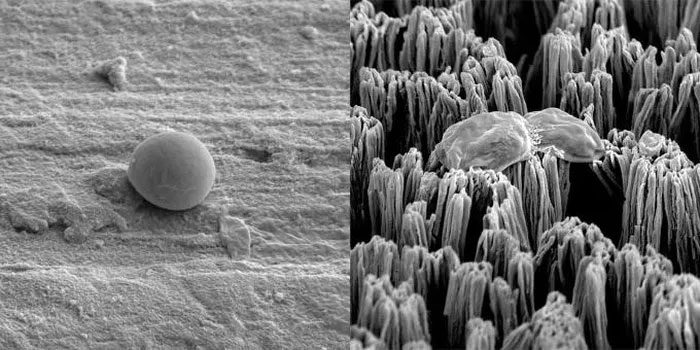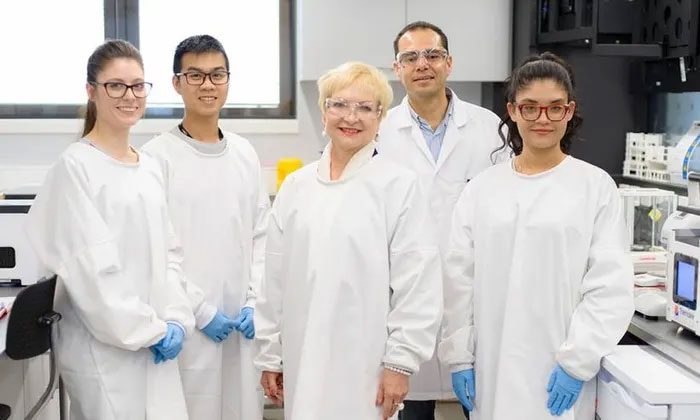Dr. Lê Hoàng Phúc (30 years old) and his team at RMIT University (Australia) have developed a model of micro-scale spikes etched onto titanium implants to protect patients from bacteria and fungi without the need for medication.
Antibacterial and Antifungal Properties

An intact Candida cell on a polished titanium surface (left) and a ruptured Candida cell on a titanium surface with micro-spikes (right). (Image: INT)
Dr. Lê Hoàng Phúc stated that since 2020, scientists have been conducting research on the surface interactions between various harmful fungal strains on nanostructured materials. The new study demonstrates that rough surfaces with micro-scale structures inspired by the antibacterial spikes on insect wings (cicadas, dragonflies) effectively combat drug-resistant superbugs, including fungi.
Currently, the rate of drug-resistant infections is increasing, raising alarms among medical experts worldwide. To prevent infections around implants, such as titanium hips or dental prosthetics, doctors often use a range of antibacterial coatings, chemicals, and antibiotics; however, these measures do not stop antibiotic-resistant strains and can even strengthen them.
The team’s approach focuses on eliminating microorganisms upon contact, thereby reducing the need for chemical interventions. Dr. Phúc, along with Dr. Denver Linklater, a member of the research team, tested several micro-scale titanium rod surfaces.
The scientists then sought to design a micro-spike model made of titanium to protect patients from bacteria and fungi without medication. The spikes are specially designed: each spike is about the height of a bacterial cell and can destroy approximately half of the harmful cells upon contact.
Notably, more than half of the remaining harmful fungal cells adhere to the surface, and although they are not immediately destroyed, they cannot survive due to injury, preventing them from reproducing or causing infections.
Metabolic analyses indicate that both Candida albicans and Candida auris (a multi-drug resistant fungus) sustain injuries that lead to their death. The damaged Candida cells continue to undergo extensive metabolic stress for up to 7 days. This interrupts the reproductive process that generates deadly fungal biofilms.
Even in a non-stressful environment, these cells cannot be revived and eventually cease functioning in a process known as apoptosis or programmed cell death.

Dr. Denver Linklater, Dr. Lê Hoàng Phúc, and their colleagues (from left to right). (Image: NVCC).
Programmed Cell Death of Pathogens
The design of surfaces capable of killing superbugs upon contact has made significant strides over the past decade. However, finding surface patterns that can eliminate 100% of bacteria, ensuring no bacteria survive to become antibiotic-resistant, remains a challenge.
“Our latest research suggests that it may not be necessary to eliminate all pathogens upon contact if we can demonstrate that these surfaces induce programmed cell death in surviving cells, meaning they will die regardless,” Dr. Lê Hoàng Phúc stated.
According to Dr. Denver Linklater, metabolic analyses indicate that damaged Candida albicans cells exhibit widespread metabolic inhibition for up to 7 days, preventing reproduction and ultimately leading to their self-destruction. The remaining cells lose their ability to survive and cease functioning (referred to as apoptosis, or programmed cell death).
This finding demonstrates that the design of antifungal surfaces can prevent the formation of biofilms from dangerous, multi-drug resistant yeast. Dr. Phúc noted that the micro-spikes made of titanium are currently undergoing feasibility testing. The team also aims to test the antifungal properties of this model against various microbial strains to optimize spike sizes for optimal antimicrobial and microbial killing effectiveness.
For over a decade, the multifunctional antibacterial materials research team at RMIT University has been a world leader in developing antibacterial surfaces inspired by the nano-patterned structures found on dragonfly and cicada wings.
This innovative surface modification technique has potential applications in medical devices but can also be easily adapted for dental applications or for other materials such as stainless steel benches used in food production and agriculture.
The team’s research was published in the journal Advanced Materials Interfaces in early September 2023, examining the effectiveness of this modified titanium surface in eradicating multi-drug resistant Candida—a fungus that can be fatal and is responsible for one of the ten most common medical device infections in hospitals.



















































